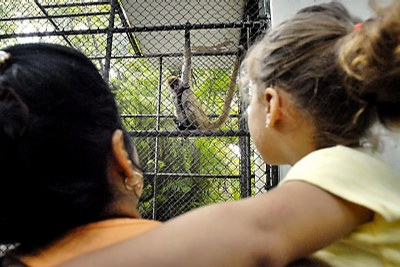A Visit to the Zoo
Daisy Valera

The largest zoo in Havana, and therefore in Cuba, is located only one a block away from the house of a friend of mine. Comparing it to the small zoo in my provincial hometown, Sancti Spiritus, this one on 26th Ave. is enormous.
Since I hadn’t stepped into a zoo for many years, and my last memories were from childhood, I wanted to see how I would feel going to see the animals at 22.
At the entrance, a family of healthy bronze deer invites you to come in.
Without thinking much about it, I was already inside, surprised that the ticket to enter this forest in the center of the city only cost me one peso in domestic currency (about 5 cents USD).
My walk began through “Monkey Island”; that’s what the section of zoo is called where these nice little animals live.
Unfortunately, many of the cages were empty and I discovered sick monkeys in the occupied ones. I left there as soon as I could, wondering what the zoo’s vet was doing about this.
I was able to see bulls, donkeys, some wolves (which seemed more like dogs), pigs and a rhinoceros. All of them seemed a little tired and hungry, and I didn’t see any food or scraps anywhere.
This pattern of empty cages was repeated in all sections of the zoo, with signs referring to nonexistent animals. The place seemed almost abandoned.
I enjoyed seeing the buffalos, which swam peacefully in a large pond, and the majority of the birds.
I regretted seeing an impressive Condor confined in a cage that was less than 13 feet high. This bird’s natural habitat is the imposing Andes.
I couldn’t see the lions in their splendor. A boney couple was taking a nap without paying attention to the visitors; it was the same situation with the leopards.
Luckily, I found the amusement park. I stayed there something like a half hour swinging in a swing until almost sunset.
When leaving the zoo I found out where the bears were, though it turned out to be a sorry sight. A brown bear and a black one shared contiguous “cages,” which were concrete pits. There was nothing green, not even a tree branch to accompany them.
Visiting a zoo when one is a little a girl is quite different from when you’re over 20.
When we’re children we’re surprised and delighted by the animals, while reflections come after growing up. As for me, I would prefer that zoos didn’t exist; there’s no need to keep animals locked up in places that don’t have the slightest resemblance to their natural habitat.
Although it’s true that zoos offer new knowledge to children, we shouldn’t sacrifice the animals for this reason alone. A program of this type can only be beautiful if it’s able to reproduce the living environments of the species that it exhibits.






I like Miss Valera’s article, because, unlike some of the writers and commentators, she writes what she sees, feels, rather than pedaling ideas. Not everything in Cuba has to do with “socialism”, “capitalist”. Zoos are zoos and monkeys are just that, monkeys.
It’s a shame that there’s no money in Cuba to maintain zoos as they are in the rich countries. But your last two paragraphs point to what our relationship to animals would likely be in the socialist future: that all such animals should be free in their natural habitat. Certainly under communism this must be so, practically by definition. And if you want to see these creatures in the flesh — then you will simply have to travel to where they live. And such excursions will certainly in no way resemble the present capitalist “safari” or “national park” system either: which interferes in all sorts of ways with the natural ecosystems of their areas, not to mention subverts the local cultures with capitalist money relations (much like Cuba presently at that, eh?).